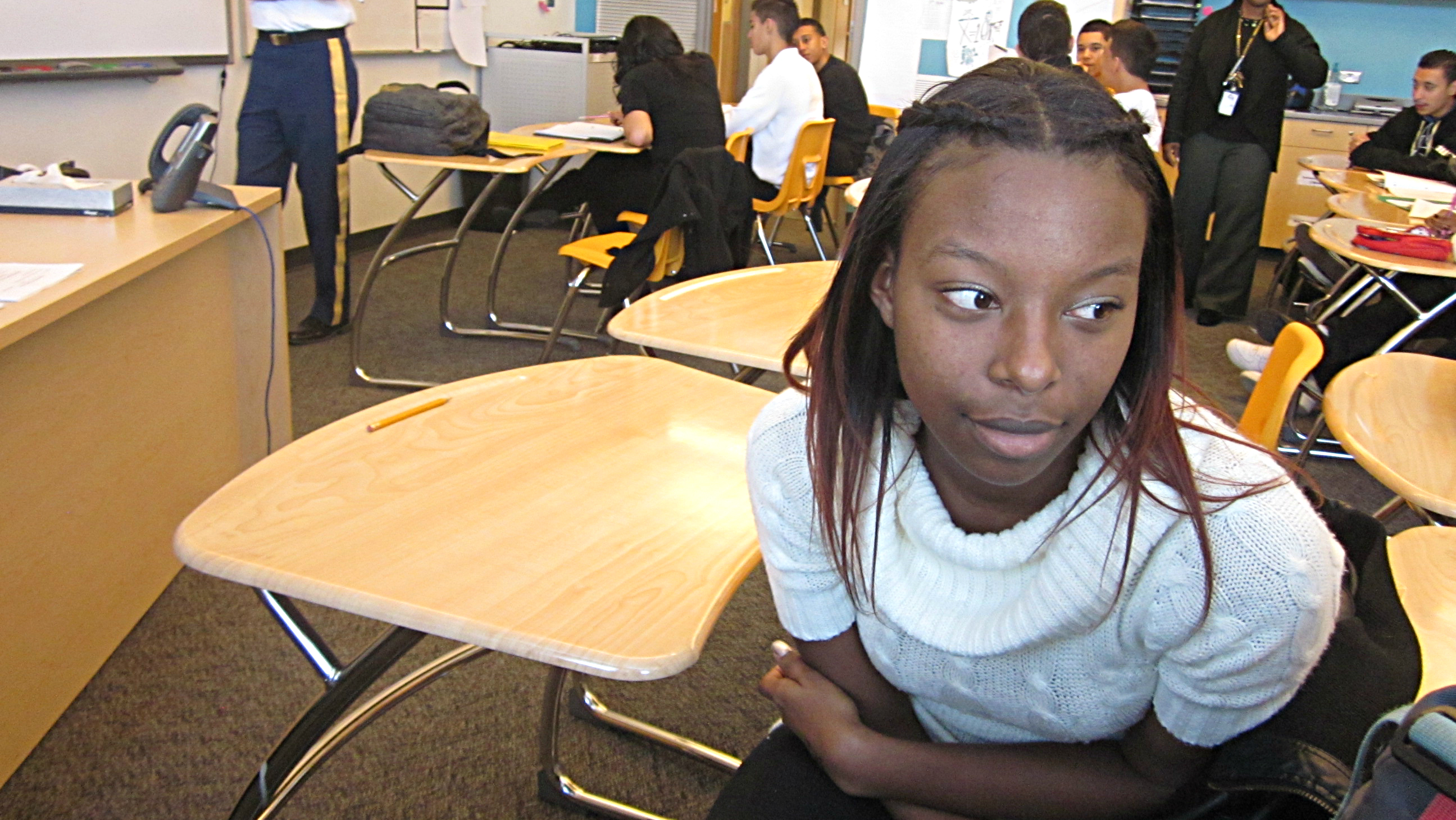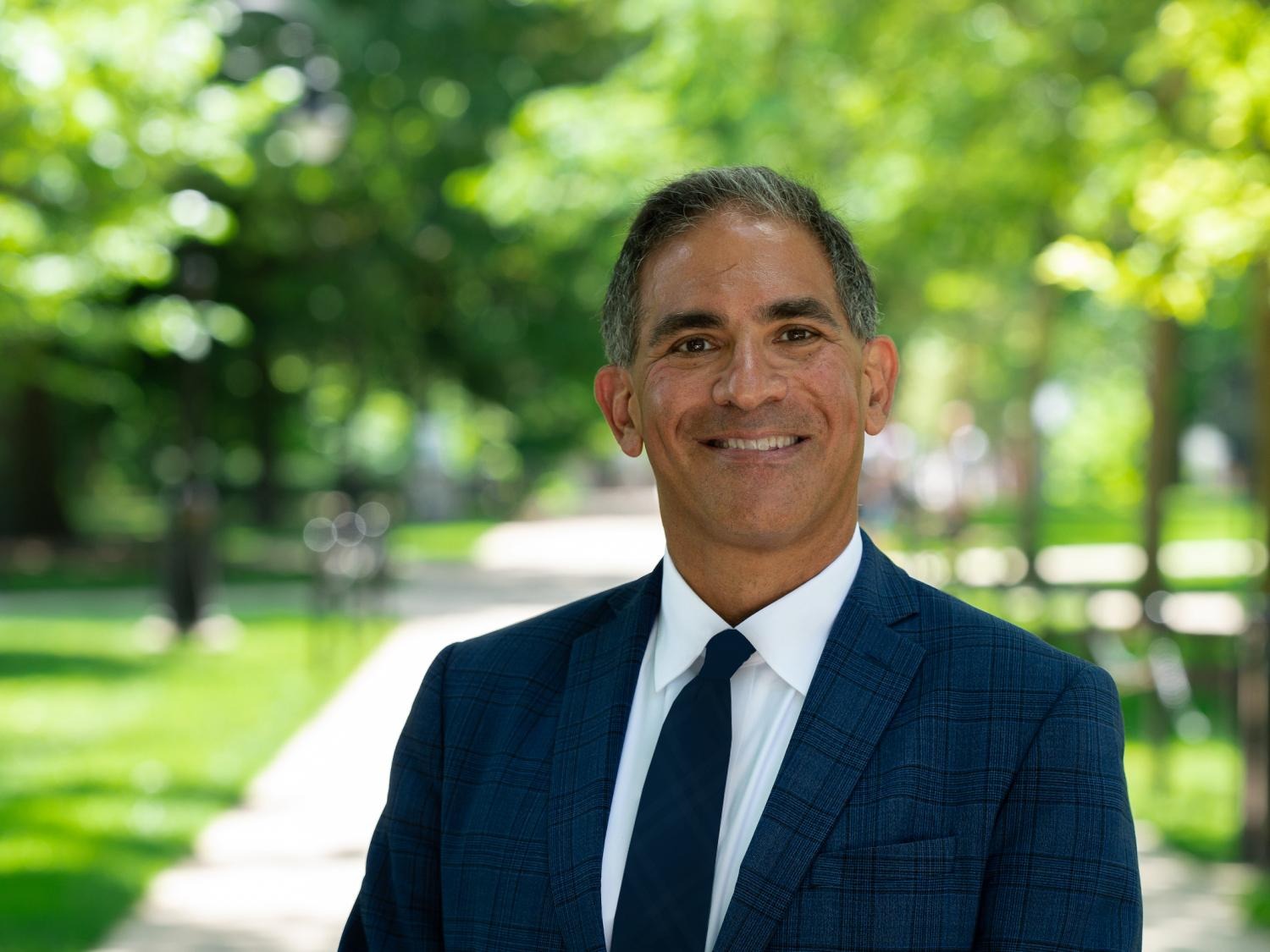
Here is a transcript of Jenny Brundin's report, followed by a transcript of her interview with Colorado Matters host Ryan Warner:
Reporter Jenny Brundin: Dajina Bell is a senior in high school. She’s African-American. She’s bright and confident. One of her favorite words to use is..
Dajina Bell: Ridiculous.
Reporter: Dajina is the kind of kid you’d think would be OK. When she was little she loved books. Couldn’t get enough of them.
Bell: I would read all day long. That's all I do is read. And that's because my mom made me read. That's all she did is make me read. So I love to read.
Reporter: Things were going well for a while. Dajina went to pre-school, kindergarten. On up through 8th grade, she liked school. The trouble came later.
Bell: When I got to 9th grade....9th grade..OK, I might cry.
Reporter: The thing that happened in 9th grade happened to her older brother, Cedric. He died. He was killed…. shot.
Bell: I didn't want to come to school. I didn't like anybody. I was mean. It was just a lot of things that progressed from there. I hated everybody. I did not want to go to school. I was mean to teachers, you know.
Reporter: One reason kids start to fall behind in school ---is something bad happens in life. You can have all the determination in the world, but something derails you. And sometimes, kids can bounce back. Especially if they have a lot of support. But Dajina’s dad wasn’t in the picture and her mom struggles with mental illness. So at school, it became hard to focus. Homework assignments stayed blank. Eventually, she stopped going to school altogether.
Bell: I didn’t like the school at all. I felt really out of place. I didn't like it.... was just very distant, I shut down in class, I didn't think about it. I didn't' learn, I didn't listen. I I felt like I did not belong.
Reporter: And her grades, as you might imagine, suffered.
Bell: I had straight Fs. Straight Fs.
Reporter: The family moved around couple times. Once they didn’t have anywhere to live. At one point in order to keep going to same school, she had a commute that would make anyone think twice.
Bell: Buses to South was ridiculous. I would take 3 buses every morning and the lightrail. just to get to school, so it was really hard to wake up 5, 4 o'clock in the morning just to get to school.
Reporter: The statistics for someone like Dajina are not great. If you’re poor, growing up, you’re less likely to make it through high school. And if you grow up with a single parent, chances are even slimmer. The numbers in Colorado on this are pretty stark. We’re working with the I-News Network, who studied census numbers, and they found that here, more than half of black homes and 35% of Latino homes with young children are headed by a single parent. And blacks and Latinos are graduating high school at a lower rate than whites. But statistics are just that. Statistics. Some people beat them.
Bell: Oh I’m doing waaaaay better than before, I mean like really, really, really better.
Reporter: It’s been a rocky road. One day she found herself in a class with a teacher who asked a simple question: how are you doing. Dajina did better in that class. Instead of an F, she got a D. But there was a glimmer there.
Bell: I mean I didn't pass....but it was better than all my other grades. She really saw the potential in me rather…. I don't know why, something about her class I just wanted to, she just brought that kind of feeling throughout like, I need to do good in her class.
Reporter: Today, Dajina’s in a new school in Green Valley. The school’s smaller, more intimate, and it’s working for her. She’s getting mostly As. But that can only do so much for her GPA. With all those Fs.
Bell: I came here with a “point something.” I’m leaving here, probably by the end of the year, with a 2.0-- which is better than anything, but that’s not what I want for myself, that’s not what I imagined. My scores are ridiculously low, my GPA is ridiculously low, I can't even get a scholarship that's how sad it is.
Reporter: Dajina is determined to go to college, somehow. Maybe study law one day. But she is definitely graduating from high school this summer. She’ll be first person in her family ever to do that.
Colorado Matters host Ryan Warner spoke with education reporter Jenny Brundin about the reasons for Colorado’s large gaps in achievement between whites and minorities. This transcript is an extended version of their conversation:
Host Ryan Warner: Jenny, how big are the gaps in Colorado when it comes to education?
Reporter Jenny Brundin: Well Ryan, they’re huge. If you look at scores on state tests, gaps between blacks and whites range from 27 to 36 percentage points. And it’s similar for Hispanics. If you look over time, our partners at the I-News Network found in terms of graduation rates, the gap between blacks and whites has improved since 1960 (the starting point for I-News’ gathering of data.) But it still hovers around 9 percentage points. And between Latinos and whites, the gap has improved slightly but in 2010 it was a staggering 30 percentage points.
Host: That would be for high school graduation. What about gaps for college graduation?
Reporter: Colorado’s gaps are the worst in the nation. The percent of whites with college degrees is three times higher than the Latino rate and double the black rate. And the gaps are growing.
Host: We’ve been talking about the achievement gap for a long time. Why hasn’t the state made more progress in this area?
Reporter: Not surprisingly, the issue is massively complex. There are many reasons for why the gap exists. Four or five reasons kept coming up in my reporting and these are: lack of funding, low expectations for minority students, poverty, failure to duplicate programs that are working, and really a lack of a concerted, integrated push to make this a priority at all levels of society. I’ll be doing stories on each of these over the course of this year.
Host: So let’s tackle what a principal told you was one of the biggest reasons for the gap is -- and that’s poverty.
Reporter: Yes, that was Bob Villareal. He’s principal at a Denver school in which virtually all the children are living in poverty. He also grew up poor.
Bob Villareal: In my home, we did not have discretionary money for books and magazines. We did not have books. We did not have magazines. The biggest thrill we received from my mother at the Goodwill in 1960, she found an encyclopedia set from 1949 at Goodwill, and we were voracious readers of those books. In the white family it's cradle to college. Beginning as a child, if you need pencil, you run at 7 o’clock, 9 o’clock to get that pencil for your son. If they need a poster board for a presentation, the white family's going to Kmart to get it. We didn't have that money.
Reporter: Low-income children tend to spend less time with books or in conversation with their parents and that means they’ve just heard fewer words spoken to them –- up to 30 million fewer words than their higher-income peers by the time they enter kindergarten. So that starts the achievement gap right there. Then it compounds over time. Not as much access to pre-school or full day Kindergarten. Researchers say teachers at high-poverty schools tend to be younger and less experienced. Classes are big. And sometimes kids with learning disabilities aren’t identified. Another reason - summer school in Colorado has virtually disappeared. So wealthier parents pay for enrichment and summer programs and tutoring while poorer kids slide backwards. Poverty also impacts the amount of time schools can spend on teaching. Here’s Henry Roman, president of the Denver Classroom Teachers Association.
Henry Roman: So if a student is sick, where does he go for care? School. If a student is hungry where does he go? He goes to school. Now we have this famous breakfast in the classroom. So at what point do schools now become a larger safety net than just instruction and pedagogy?
Reporter: He and many others believe the resources aren’t there to meet all the demands.
Host: Which brings us to funding and its role in the achievement gap….
Reporter: I should be clear. A couple of people I spoke with didn’t believe Colorado’s low state funding for students plays a role in the achievement gap. They point to a handful of schools in Colorado that have shown good results in this regard. But others say Colorado is really at the bottom of the barrel and more targeted spending could show big improvement. To give you an idea of the plummet -- in 1992 Colorado was 24th in overall state spending on public schools. It’s now 42nd. And for colleges - only New Hampshire and Vermont spent less per full-time college student than Colorado. Lisa Weil of Great Education Colorado says it’s frustrating because there are several things research has shown boosts achievement.
Lisa Weil: We know that early childhood works; we know that full day Kindergarten works, but those are going to require new resources. We know that individual attention is important. We know that counselors are very important. We’ve got 400, 500 students to a counselor. We know what works, and for a number of reasons that range from our constitution to political decisions, we are simply not doing that. We have the capacity and we’re not using it.
Reporter: Colorado gives extra money to schools to account for the needs of poor students - but people say it’s not enough because schools aren’t getting enough to begin with. And overall Colorado schools have lost about a billion dollars from what voters intended when they passed Amendment 23 in 2000- that’s because of a legislative maneuver several years later that in effect allowed the education budget to be cut - specifically money that would have gone to support struggling students.
Host: Onto another issue that isn’t discussed much. One thing we know is that housing patterns create racially segregated schools. How is that feeding into the achievement gap?
Reporter: The evidence is incontrovertible. In low-income neighborhoods, achievement is lower. Here’s former DPS school board member Nate Easley.
Nate Easley: There are very few exceptions of segregated schools -- either they are ethnically, or segregated socio economically, or both, in most cases both – that are high performing. There are exceptions – but they’re not the rule. By rule, a school is segregated and its low income, it’s going to be low performing school.
Reporter: There is a body of research that shows integrated schools help minorities achieve. But we’ve largely returned to a system of segregated schools in most of Colorado’s highly urban areas. Nate Easley is floored that no one is talking about it. But – no one wants to return to mandatory busing – and even so, when you have a district like Denver’s that’s about three-quarters minority students– there aren’t enough white students for a fully integrated school system!
Host: So how does a district like Denver work around that?
Reporter: There have been programs created, like the gifted and talented program – to draw white families back to city schools. But Van Schoales, director of the education reform group A+ Denver, says you’ll find those specialized programs are for the most part populated by higher income white families.
Van Schoales: So on a per-pupil basis, the inequities between a college bound kid and a non-college bound kid in a typical urban or in some cases suburban high school are massive, in terms of the support they’ll get.
Reporter…like AP classes with highly experienced teachers, often in smaller-sized classes. Schoales’ view is that Denver is really the only district that’s making headway on the achievement gap. One thing the district tried to do is make it easier for families in poor neighborhoods to enroll in a high-performing school elsewhere in the district and….even create new, high-performing schools right in poor neighborhoods.
Host: Well we’ve talked about low funding and poverty. You also mentioned that low expectations can be a drag on student performance?
Reporter: Teachers - just like most everyone else - have their own biases; they make assumptions about whether kids who are poor, or come from troubled homes, can truly learn. In fact, studies have shown that when teachers were told students were likely to do well, even when they weren’t, the students did better. Here’s Nate Easley again.
Easley: I think we tend to focus on kids deficits. We tend to look at their home situation, or we tend to look at the fact that they’re not eating breakfast and we make excuses for them to fail. And when the system does that, then I think students will live down to the expectation that the system has of them.
Reporter: His own research for his doctoral dissertation on Mexican immigrants suggests that many felt they were stereotyped and sent to remedial classes. He supports classrooms that focus on the assets of the students. Others, like Pam Martinez of the youth activist group Padres y Jovenes Unidos, said the same thing:
Pam Martinez: I think there’s a thread running through all high-performing schools with low income kids over color, and that is people have confidence in and believe in the intellectual capacity of the students in those schools regardless of class, race, learning a second language, and status, legal status. Regardless of what your zip code is, they absolutely believe in the intellectual capacity of the students, and so the bar is raised and conditions are set to catch up, believing that they actually can do that. And they do.
Reporter: She points to STRIVE Prep. This is a network of high-performing charter schools that serve a largely low-income, minority population with pretty great results. She and others are frustrated that these models aren’t being replicated faster in Colorado.
Host: Jenny, some people you talked to believe there’s a culture gap feeds into the achievement gap? Will you explain that for us?
Reporter: Yes, DPS substitute teacher Aubrey Valencia has thought a lot about this. She’s been in almost all the schools in Denver and has really observed a lot. She was also part of a Latino council that advised the Denver school board. She sees a cultural conflict playing out in classrooms, students, often of color, are coming in with one idea about the world, and teachers, largely white, with another, and it results in disruptive behavior and discipline problems. And she says, teachers are dissuaded from getting too involved in their students’ lives when in fact - the opposite should occur.
Aubrey Valencia: So probably one of the biggest factors in culturally responsive education is that teachers develop a very strong personal relationship with their students. Especially students who are coming from homes that is maybe unstable because there’s poverty, or drug issues, or maybe there’s something with immigration or any number of things that can disrupt a student’s ability to learn. If the teacher doesn’t even know any of that is going on – how can they bridge those gaps between life and school?
Reporter: She’d like to see teachers get more help in understanding the home lives and cultures of the students they teach, but also how not make assumptions based on it; advocates say teachers need to help students learn the “hidden” curriculum, the new rules of the school culture that are very different from the home culture.
Host: So Jenny, what’s next?
Reporter: Most everyone I spoke with thinks there needs to be a full frontal assault on the achievement gap. It will also take many bold initiatives in the classroom and in districts. More duplication of what’s working. More investment in social service workers and mental health counselors. Greater systems of support to bridge the world of poverty to the world of college. Van Schoales with A+ Denver points out though, that the state is not going to make progress until leaders have clearly defined goals about reducing the achievement gap - which the state doesn’t have. Pockets of great things are happening - and we’ll talk about some solutions in stories I’ll do this year. But until there’s a large-scale mobilization on many fronts, former DPS board member Nate Easley fears this prediction will hold true:
Nate Easley: Right now today, I can almost predict where you’re going to be based on your mother’s educational level and your family income. If you put those two things together – it’s a pretty strong predictor of whether or not you’re going to finish college and how much money you’re going to make in your lifetime. And until we correct that, our democracy’s in jeopardy.
Host: Jenny, thanks for being with us.
Reporter: Thank-you.








